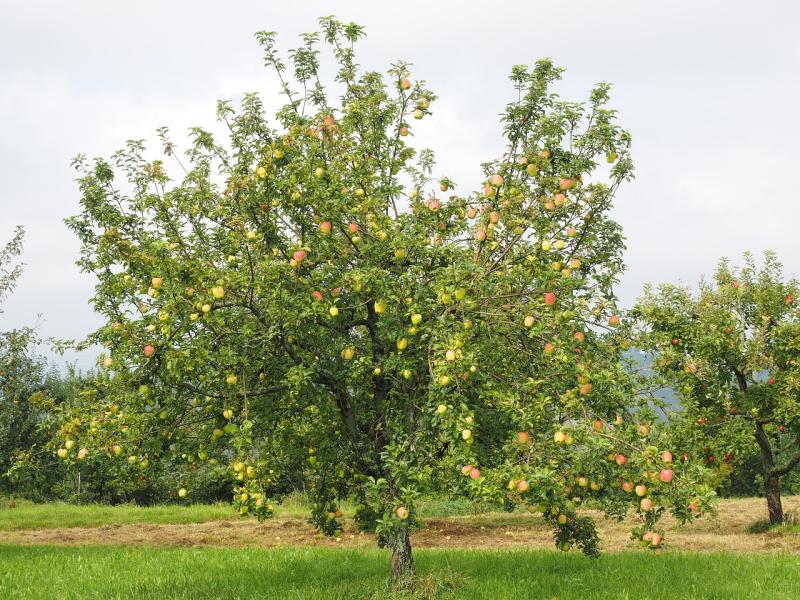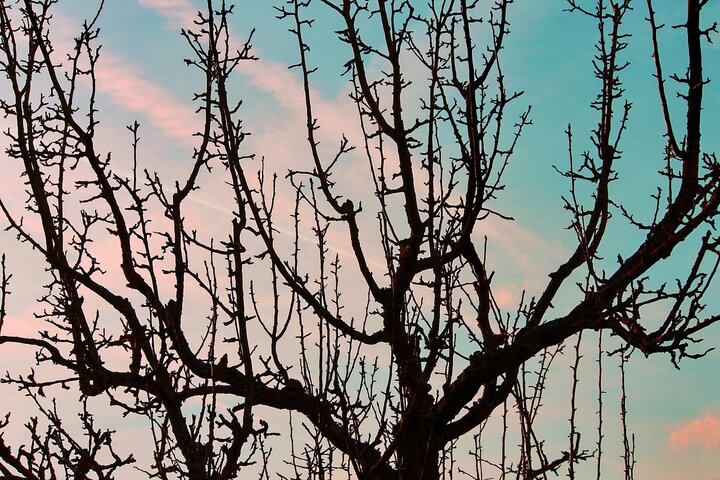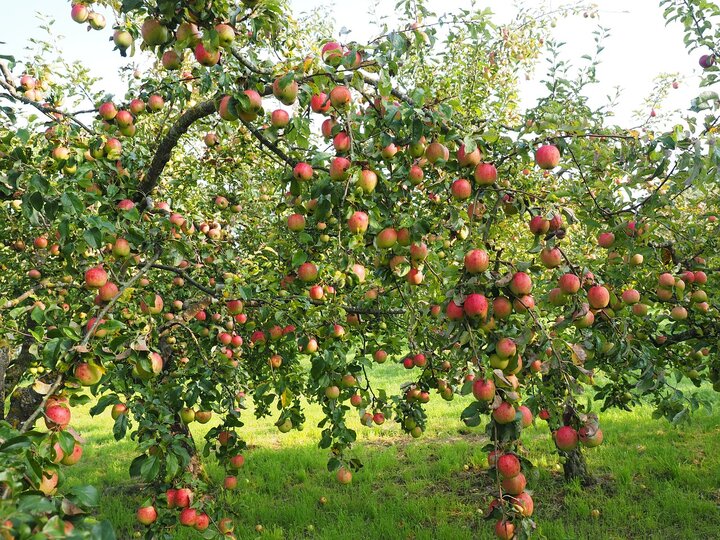Sarah Browning, Nebraska Extension Educator

Healthy productive fruit trees require good care and pruning. Image from Pixabay.com
Productive fruit trees with an abundance of high-quality fruit don't just happen. They result from good cultural practices, including pruning. However, fruit tree pruning is often neglected by the home gardener either due to a lack of pruning skills and knowledge, or due to fear plants will be damaged or killed by incorrect pruning.
There are basically two stages of fruit tree development, each with different goals and pruning strategies. Young trees, 4-5 years or younger, are pruned or “trained” to create a basic framework of branches for future growth. Older established trees, which have already developed a good branch structure, are pruned primarily for optimum fruit development.
Goals of Pruning
The goals of fruit tree pruning are many, including:
- Obtaining maximum light exposure for both leaves and fruit.
- Providing uniform distribution of fruiting wood along the scaffold branches.
- Controlling the tree’s size and vigor.
- Reducing limb breakage due to excessively heavy fruit loads.
- Producing high quality fruit of good size.
An important goal for backyard gardeners is creating trees small enough to spray and harvest easily. Pruning, combined with the use of dwarf fruit tree cultivars, helps accomplish this goal.
When to Prune
Most fruit tree pruning is done during the dormant season, February through early April. Apple, pear, tart cherry and plum trees should be pruned first; more cold tender trees including peach, apricot and sweet cherry should be pruned in late March just before bud swell. Regardless of the cultivar grown, do not prune any tree before January or winter injury is likely to occur.

Pruning Established Tree
Mature fruit trees should be pruned with the following goals in mind.
- Remove dead, diseased and damaged branches each year. Starting the pruning process by removing these branches gives you a clear starting point. It also maintains tree vigor by removing sites of potential insect and disease infestation.
- Remove water sprouts and suckers. Water sprouts and suckers are quickly elongating vertical shoots that originate from the roots or above ground parts of the tree. This is another easy place to begin pruning since water sprouts and suckers are easily identified.
- Remove the weakest of crossing or closely parallel growing branches. Branches that cross and rub against each other can produce wounds which provide a site for disease and insect infestation. Parallel branches compete for resources, resulting in smaller fruits on both branches.
- Remove branches growing in towards the center of the tree. Thin out branches as necessary to increase light penetration to the center of the tree.
- Remove severely shaded branches. Branches which are heavily shaded will not develop many flowers or fruits.
- Removal of large limbs may be necessary if the tree was not properly pruned when it was young. Do not remove more than 2-3 large limbs each year. Over pruning in a single season can stimulate excess water sprout development.
- Finally, look at the tree’s overall height. Remove height from the tree as needed to maintain a manageable size for harvesting and spraying. Cut tall branches back to an outward-facing secondary branch which is at least 1/3 the girth of the branch section being removed.
When pruning, always use tools made for tree pruning and keep them clean and sharp. In trees prone to fireblight, disinfect the equipment between pruning cuts, use either a 70% denatured alcohol solution or household bleach at a rate of one part bleach to nine parts water. Either use a sponge or dip the equipment into these solutions.
But remember, bleach causes metal tools to rust, so clean and oil them well at the end of each day.

Final Step – Fruit Thinning
The final step to maintain an established fruit tree which produces abundant, good-sized fruits each year, is thinning some fruits from the tree in early summer. Most trees set too many fruits each spring. The result is small fruit sizes and poor quality. Excessive fruit loads reduce the following year's crop and may cause the tree to develop a pattern of alternate year bearing.
Tremendously heavy fruit loads can even cause branches to break. Backyard gardeners should hand-thin excess fruits, after the flower petals have dropped and the small, young fruits can easily be seen on the branches. For maximum size fruits, thin apples to one fruit every six inches, plums 2-3 inches and peaches 6 inches. Tart cherries don't require thinning.
Pruning Workshop – Thursday Nov. 9th
Southeast Community College is offering a class on fruit tree pruning taught by Vaughn Hammond, Vala’s Pumpkin Patch agriculture and orchard manager. The class is scheduled for Thursday November 9thfrom 6:30 to 8:30 p.m. Cost $39.00/person. Visit southeast.edu and search for “pruning” to register. The program will be held at the Nebraska City Learning Center, 1406 Central Avenue. Don’t miss out on this great opportunity!
Check out these resources with more information on fruit tree pruning.
- Pruning and Training Backyard Apple and Pear Trees.Michigan State University
- Midwest Home Fruit Production Guide. Ohio State University Extension
Images from Pixabay.com.
- Prune fruit trees when dormant, February through early April. Branch structure is easy to see at this time of year and pruning wounds heal fastest when pruning is done just before new growth begins.
- Excessive fruit load can result in branch breakage, along with small fruits with low quality.
Search Our Archive
Associated Video
Apple Tree Pruning
Nebraska Extension Landscape Horticulture Specialist Kim Todd interviews Kimmel Orchard Operations Manager Vaughn Hammond about timing and technique for apple tree pruning.